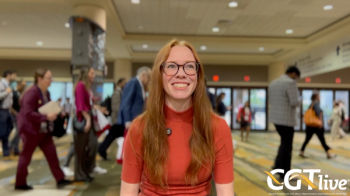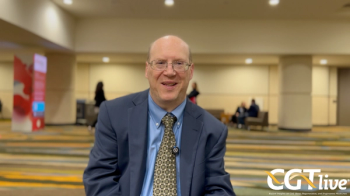
CRISPR/Cas9 Edited Allograft Eases AEs of Maintenance Therapy for AML
A CRISPR/Cas9-edited allogeneic stem cell transplantation effectively reduced hematopoietic toxicity associated with maintenance gemtuzumab ozogamicin for high-risk acute myeloid leukemia (AML).
A gene-edited allogeneic stem cell transplantation to remove CD33 using CRISPR/Cas9, also known as trem-cel, effectively limited hematopoietic toxicity that frequently limits the use of maintenance gemtuzumab ozogamicin (Mylotarg) for patients with high-risk acute myeloid leukemia (AML), according to findings from the VBP101 trial presented at the 2023 ASH Annual Meeting.
“All 8 patients transplanted with trem-cel demonstrated primary neutrophil engraftment, with early neutrophil engraftment between days 8 and 11, similar to patients who received non-edited CD34 selected grafts,” said lead investigator John F. DiPersio, MD, PhD, Division of Oncology, Washington University School of Medicine. “The dose of 0.5 mg/m2 of gemtuzumab ozogamicin post-transplant is very well tolerated after stem cell transplant. The next step is dose escalation, and the study is now open for patients 1 mg/m2 of gemtuzumab ozogamicin.”
Targeting of specific molecules results in anticancer activity but also leads to on-target toxicity, as healthy cells that express that target are also impacted. In AML, CD33 is targetable using the gemtuzumab ozogamicin, but at the cost of on-target neutropenia and thrombocytopenia, DiPersio noted. These adverse events (AEs) have limited its use, specifically in the post-stem cell transplant setting.
To overcome this, researchers hypothesized that CD33, the target of gemtuzumab ozogamicin, could be removed from allograft, as it was largely dispensable, allowing the agent to target just the AML cells while sparing those transplanted to the patient. This target can easily be deleted, since it is isolated to the hematopoietic compartment, with mouse models showing successful self-renewal of CD33-deleted hematopoietic stem and progenitor cells and case studies existing of healthy individuals with CD33 loss of function. Additionally, while this research was undertaken with gemtuzumab ozogamicin, there is potential to develop CD33-directed CAR T-cell therapies, if the on-target AEs can be overcome, noted DiPersio.
For the trial, patients with 10/10 HLA-matched related or unrelated donors were selected, and donor CD34-positive cells were subsequently edited using CRISPR/Cas9 to develop the final engineered hematopoietic stem cell product (trem-cel). All patients included in the study were CD33-positive, with at least 1% expression. Patients in the study had risk factors indicative of relapse, such as minimal residual disease positivity or adverse genetics.
There were 8 patients included each with a 10/10 HLA-matched donor, only 1 of which was related. CD33 was removed for approximately 87% to 91% of cells. The ages of patients ranged from 32 years to 68 years, and sex was split evenly between male and female. The number of CD34-positive cells from the donors ranged from 2.6 x 106 to 9.5 x 106. Prior to infusion, all patients received myeloablative conditioning with busulfan, melphalan, and fludarabine. Seven patients received rabbit anti-thymocyte globulin (ATG) and 1 patient received equine ATG.
Following infusion of the gene-edited cells, neutrophil engraftment and platelet recovery were in line with expectations for unedited CD34-selected allografts. There was full myeloid chimerism seen in all patients by day 28, except for the patient who received equine ATG. This patient developed thrombocytopenia. Neutrophil engraftment was seen at day 11 and platelet recovery was seen at day 17.
There were 3 patients who were deemed ineligible for gemtuzumab ozogamicin, due to graft failure, immune thrombocytopenia, and rapid relapse. Of the remaining 5 patients, there were no dose-limiting toxicities seen with 0.5 mg/m2 gemtuzumab ozogamicin. Moreover, there were no increases seen in liver function tests and no signs of veno-occlusive disease/sinusoidal obstruction syndrome. Platelet and neutrophil counts remained flat from day 1 to day 140 of gemtuzumab ozogamicin.
“Pharmacokinetics showed a higher gemtuzumab ozogamicin exposure in context of CD33-negative hematopoiesis,” DiPersio noted. “Modest increase in fraction of CD33-negative peripheral blood cells after gemtuzumab ozogamicin dosing suggests enrichment potentially at the progenitor level.”
The dose escalation committee for the trial recommended increasing the dose of gemtuzumab ozogamicin to 1 mg/m2, which will be further examined as part of the study. Continued follow up with all be completed for those enrolled.
REFERENCE
DiPersio J, Cooper BW, Such HC, et al. Trem-cel, a CRISPR/Cas9 Gene-Edited Allograft Lacking CD33, Shows Rapid Primary Engraftment with CD33-Negative Hematopoiesis in Patients with High-Risk Acute Myeloid Leukemia (AML) and Avoids Hematopoietic Toxicity During Gemtuzumab Ozogamicin (GO) Maintenance Post-Hematopoietic Cell Transplant (HCT). Blood. 2023;142(suppl 1):483.doi:10.1182/blood-2023-190037.
Newsletter
Stay at the forefront of cutting-edge science with CGT—your direct line to expert insights, breakthrough data, and real-time coverage of the latest advancements in cell and gene therapy.
















































